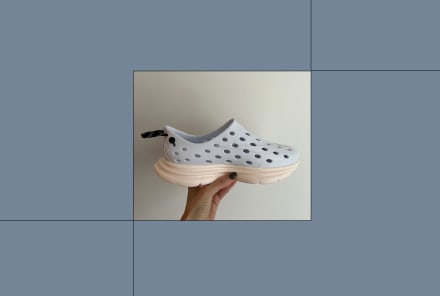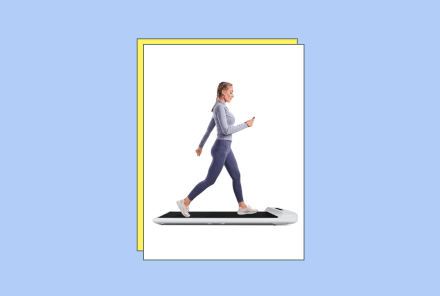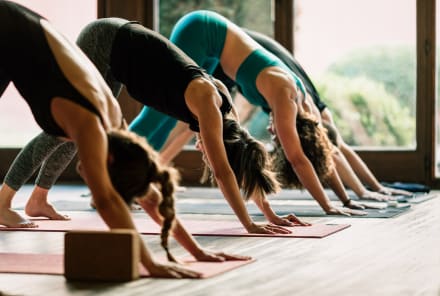Advertisement
How I Got Back Into The Gym After Rhabdo: 3 Essential Tips

When I landed myself in the hospital with rhabdomyolysis1 after a workout, I was surprised. After all, I do yoga and Pilates a few times a week. I was a varsity athlete in high school, and even now at 32, I still consider myself in fairly good shape. But when I started a new strength-training regimen, things went south pretty quickly.
The exercise that sunk me was a seemingly simple, low-intensity movement called the negative pull-up: essentially jumping up to hold my chin above a bar, then slowly lowering myself down using my body weight as the force. The trainer had me doing six sets of four reps each, but by the third set, I physically couldn’t hold myself up anymore without assistance. In hindsight, I should have called it quits, but not knowing that rhabdo even existed, I pushed through it. The next day, my lat muscle was so swollen that it jiggled when I walked, and a few days later, my entire upper body looked like a puffy marshmallow.
I Googled (of course) to see if swollen muscles were normal (they’re not) and texted a few friends to ask if they’d ever experienced anything similar (they hadn’t). Everyone told me I was likely overreacting, but I couldn’t shake the feeling that something was seriously wrong.
Despite my friend’s advice and a clueless doctor at urgent care who recommended I go for acupuncture, I headed to the emergency room where they immediately sent me for an EKG and hooked me up to an IV of fluids. With rhabdo, the overworked muscle dies, resulting in a flood of toxins, dead cells, and minerals that the kidneys can’t flush fast enough. The buildup can cause kidney failure, or in other cases, heart failure because of the sharp increase in minerals like potassium.
I ended up staying for five days on a round-the-clock IV drip until my levels dropped below the danger threshold. Normal readings of the enzyme CPK (creatine phosphokinase) register at 120 micrograms per liter or less. When I arrived at the ER, mine had skyrocketed to 55,000 and needed to be monitored every six hours.
Getting back to the gym after rhabdo.
While I was in the hospital, I had plenty of time to research more about rhabdo. I found out it’s most common in people who are dehydrated or doing an exercise for the first time: High-intensity workouts like CrossFit and spin classes like SoulCycle are likely culprits. Though there’s a decent amount of info on the causes of rhabdo, little was written about recovery. I read plenty of horror stories about people never "bouncing back," but articles about how to get back into the gym after rhabdo were nonexistent. What I did find was discouraging: A few sources said you should never work the injured muscle again for fear of relapse, which seemed ridiculous to me.
After leaving the hospital, I took another week to recover and de-puff (I’d gained 12 pounds in swelling and fluid retention), then set my sights on how to safely ease back into the gym. I started working out with Paul Kostas, director of personal training at Brooklyn Athletic Club. He helped me gain back my confidence in my workouts and says that many of the techniques he taught me can be translated to working out again after any injury, not just rhabdo. Here's what I learned:
Identify your body's limitations and what caused the injury in the first place.
In the case of my rhabdo, I’d done very elongated sets repeatedly on a muscle group that wasn’t prepared for that level of exertion. Obviously knowing about rhabdo could have prevented me from pushing myself to the extreme, but I’d trusted the trainer to know my limits, something that Paul says can actually lead to injury:
"You have to listen to yourself. When your body starts to say no, sometimes the hardest part is speaking up to a coach or a trainer. In some cases, they might say to keep going, but when you know you've hit that point, you just have to stop." For me, it should have been a massive red flag when I physically couldn’t do the exercise without help from the trainer holding me up. While there aren’t any tried-and-true signs or symptoms that an injury is about to take place, reaching muscle failure is a good clue that you should quit.
Determine appropriate levels of muscle soreness.
Another thing that kept me from seeking medical attention right away was the idea that I was supposed to be super sore. I’d always worn soreness after a workout as a badge of honor that I’d done a good job, so when I couldn’t lift my arms over my head, I quietly patted myself on the back. Now I know that it’s important to identify the difference between being in pain and being sore.
To determine what’s an acceptable level of soreness, you should pay attention to whether the tenderness is incapacitating. A little bit of stiffness and pain is normal, but if there is any swelling or bruising or you can't walk—you've gone too far. If you’ve already hurt yourself, it’s critical that you take it slow and steady to build back both your physical and mental strength. Paul explained to me that "The biggest mistake I see people making after an injury is trying to pick up right where they left off. You need to ease yourself back in and give your body a chance to rest and re-acclimate. Unfortunately, it takes a lot longer for tissues to heal than you’d like it to, so having patience is key." You also might need to backtrack even more than where you originally started to allow the body to repair.
Find a trainer who will meet you where you are.
If it’s in your budget, hiring a trainer to watch your form and work with you on proper technique is one of the quickest ways to get back into working out. I was scared to do anything remotely similar to the exercise where I’d hurt myself, so it was beyond helpful to have Paul there to support me during my moments of fear or reassure me that I wasn’t going too far. A good trainer will be able to meet you where you are and assist you at a speed that’s right for you.
When you’re interviewing trainers, do your research and don’t forget to ask for their certification. The national certification organizations are the NSCA, ASCM, NASM, and the ACE, and while it’s certainly possible to find a great trainer that’s certified outside of these large organizations, you should be careful.
Here’s a list of additional questions to ask a potential trainer:
- What's your training experience and background?
- How long have you been training?
- Have you worked with people in post-rehab settings?
- What's your experience with people with injuries?
- Are you familiar with my injury and confident working with me?
- Do you have reviews or can any of your clients speak to your success?
Though I’m still working my way up to being able to do the negative pull-ups that gave me rhabdo, I feel much more prepared to get there the right way. Getting rhabdo was terrifying, but I walked away with a better understanding of the limits of my own body and the confidence to say no when I’ve reached them.
Want to learn more about rhabdomyolysis? Here's when you should be worried about your exercise habits.
Watch Next
Enjoy some of our favorite clips from classes
Enjoy some of our favorite clips from classes
What Is Meditation?
Mindfulness/Spirituality | Light Watkins
Box Breathing
Mindfulness/Spirituality | Gwen Dittmar
What Breathwork Can Address
Mindfulness/Spirituality | Gwen Dittmar
The 8 Limbs of Yoga - What is Asana?
Yoga | Caley Alyssa
Two Standing Postures to Open Up Tight Hips
Yoga | Caley Alyssa
How Plants Can Optimize Athletic Performance
Nutrition | Rich Roll
What to Eat Before a Workout
Nutrition | Rich Roll
How Ayurveda Helps Us Navigate Modern Life
Nutrition | Sahara Rose
Messages About Love & Relationships
Love & Relationships | Esther Perel
Love Languages
Love & Relationships | Esther Perel











